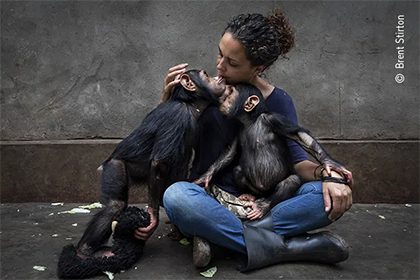
BRENT STIRTON’S IMAGE – The healing touch
The director of the centre sits with a newly rescued chimp as she slowly introduces it to the others.
Young chimps are given one-to-one care to ease their psychological and physical trauma. These chimps are lucky. Less than one in ten are rescued after having seen the adults in their group killed for meat. Most have experienced starvation and suffering.
Vincitore – Premio storia fotogiornalistica

FOTO DI BRENT STIRTON – Tocco guaritore
La direttrice del centro siede con un nuovo orfano mentre lo presenta lentamente agli altri.
I giovani scimpanzé ricevono cure in rapporto 1-1 per superare i loro trauma fisici e psicologici. Sono fortunati, meno di uno su dieci viene salvato dopo aver visto uccidere tutti gli adulti della sua famiglia per la carne. La maggior parte soffre la fame e il dolore fisico.
Dettagli tecnici:
Canon EOS 5D Mark IV + 16–35mm; 1/250 sec a f5.6; ISO 400
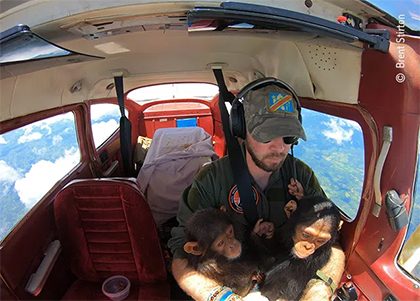
BRENT STIRTON’S IMAGE – Flying rescue
Virunga National Park pilot Anthony flies two orphan chimpanzees to safety at the rehabilitation centre.
The babies were rescued from traffickers following a tip-off from locals. Baby chimps have little meat value, but are often sold as pets or for animal shows. At this stage they are unlikely to survive without specialist care, needing formula milk and regular balanced meals.
Vincitore – Premio storia fotogiornalistica

FOTO DI BRENT STIRTON – Volo di salvataggio
l pilota Anthony del Virunga National Park porta in volo due orfani verso la salvezza del centro di riabilitazione.
I piccoli sono stati salvati dai trafficanti grazie ad una soffiata dei locali. Essi non hanno valore per la carne, ma spesso vengono venduti come animali da compagnia. In questa fase difficilmente sopravvivrebbero da soli, hanno bisogno di una particolare formula per il latte e pasti regolari bilanciati.
Dettagli tecnici:
oPro Hero 7; 1/250 sec a f8; ISO 200
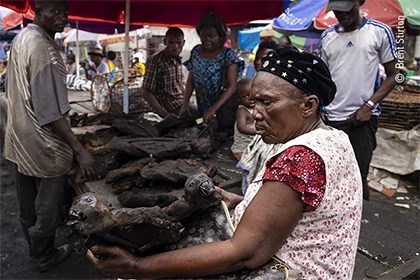
BRENT STIRTON’S IMAGE – Illegal business
A bushmeat stallholder in the port area of Kinshasa displays smoked carcasses of primates.
These primates were bought from a trader who ordered them from hunters and had them shipped down the Congo River. All monkeys and apes in the Democratic Republic of the Congo are now threatened. Limited awareness and enforcement of laws around bushmeat trade are contributing factors.
Vincitore – Premio storia fotogiornalistica

FOTO DI BRENT STIRTON – Business illegale
Un venditore di carne di animali selvatici nel porto di Kinshasa mostra carcasse di primate affumicati.
Questi sono stati comprati da un commerciante, che li ha ordinati a dei cacciatori, i quali li hanno spediti lungo il fiume Congo. In questo Stato attualmente tutte le scimmie sono minacciate. Sicuramente contribuiscono una scarsa consapevolezza e leggi inadeguate.
Dettagli tecnici:
Canon EOS R5 + 24–70mm; 1/500 sec a f6.3; ISO 400
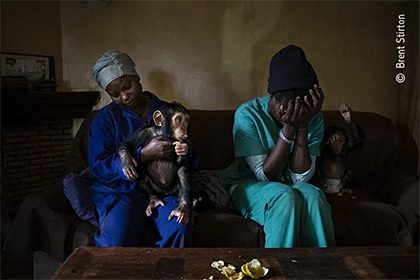
BRENT STIRTON’S IMAGE – Caring duties
Lina, a vet, dressed in green, and Florence, a caregiver, are exhausted after many hours of looking after energetic young chimpanzees.
Caring for any infant chimpanzee is a 24-hour experience. While studying to be a vet, Lina was wounded in a grenade attack by rebels. She says that feeling like a survivor herself has made her closer to the chimps she cares for.
Vincitore – Premio storia fotogiornalistica

FOTO DI BRENT STIRTON – Doveri di cura
Lina, veterinaria vestita di verde, e Florence, caregiver, sono esauste dopo tante ore a curare i giovani e vivaci scimpanzé, un’esperienza h24.
Mentre studiava per diventare veterinaria, Lina è stata ferita da una granata dei ribelli. Dice che sentirsi essa stessa una sopravvissuta la avvicina agli scimpanzé di cui si prende cura.
Dettagli tecnici:
Canon EOS 5D Mark IV + 16–35mm; 1/125 sec a f2.8; ISO 4000
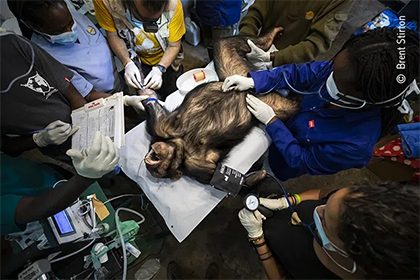
BRENT STIRTON’S IMAGE – Chimp check-up
Vets perform a health check on a rescued chimpanzee.
The chimps are likely to have lived lives of isolation and suffering. Most are malnourished and sick, and may be carrying infectious diseases. This youngster lost its hand to a snare. A varied diet aids recovery and the centre provides fruits, vegetables and beans purchased from local farmers, supporting the surrounding community.
Vincitore – Premio storia fotogiornalistica

FOTO DI BRENT STIRTON – Controllo
I veterinari fanno un controllo della salute di uno scimpanzé salvato. Probabilmente, come altri ha vissuto solitudine e sofferenza.
La maggior parte sono malnutriti e malati, e possono portare malattie infettive. Questo giovane ha perso la sua mano in un laccio. Una dieta varia aiuta nella ripresa e il centro fornisce frutta, verdura e fagioli acquistati al mercato locale, per supportare la comunità circostante.
Dettagli tecnici:
Canon EOS 5D Mark IV + 16–35mm; 1/160 sec a f2.8; ISO 3200

BRENT STIRTON’S IMAGE – Making friends
Two newly rescued chimpanzees are carefully introduced into the juvenile enclosure at the center.
The babies are introduced slowly, initially kept separate from the larger juveniles, allowing them to gently meet the group. They will be closely monitored by the caregivers, who live with the chimpanzees day and night. The hope is to eventually release the chimpanzees back into the wild.
Vincitore – Premio storia fotogiornalistica

FOTO DI BRENT STIRTON – Fare amicizia
Due scimpanzé appena recuperate vengono con attenzione introdotti nel recinto del centro.
Inizialmente vengono tenuti separate dai giovani più grandi, per consentire un incontro gentile e lento. Verranno monitorati attentamente, giorno e notte, e la speranza è di rilasciarli poi in natura.
Dettagli tecnici:
Canon EOS 5D Mark IV + 16–35mm; 1/250 sec a f7.1; ISO 400
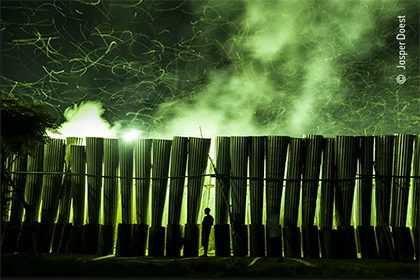
JASPER DOEST’S IMAGE – Lured by light
A vivid light illuminates the darkness, highlighting the swirling of insects amid billowing smoke.
This is a trap to lure and capture bush crickets as they swarm over the Ugandan city of Masaka. The insects are attracted by the bright halogen lights and, sedated by smoke, they crash into the upright metal sheets and then slide into oil drums.
Menzione speciale – Premio storia fotogiornalistica

FOTO DI JASPER DOEST – Attirati dalla luce
Una luce vivida illumine l’oscurità, evidenziando lo sciame di insetti nel fumo.
Questa è una trappola per catturare i grilli quando si muovono in massa vicino alla città ugandese di Masaka. Gli insetti sono attratti dalla luce delle lampade alogene, e sedati dal fumo, che li fa sbattere contro le lamiere e scivolare nei barili metallici.
Dettagli tecnici:
Leica SL + 16–35mm; 1/2 sec a f4.4 (-0.7 e/v); ISO 125
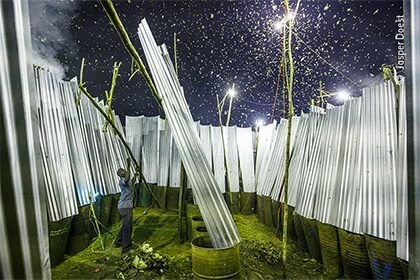
JASPER DOEST’S IMAGE – Trap-setting
Nsenene swarms can be difficult to predict, and Jasper felt lucky to have captured this sky full of insects.
He photographed a man replacing a halogen lamp used to lure them into traps. The 400-watt mercury bulbs emit blindingly bright light to attract the insects, but can also pose health risks to those who work around them.
Menzione speciale – Premio storia fotogiornalistica

FOTO DI JASPER DOEST – Posizionamento trappole
Le sciamature di nsenene sono difficili da prevedere, e Jasper si è sentito fortunate quando ha fotografato questo cielo pieno di insetti.
Ha ritratto un uomo mentre cambiava una lampada alogena, usata per attirarli. Le lampadine da 400watt emettono una luce forte che funziona bene allo scopo, ma che può essere anche pericolosa per la salute di chi ci lavora.
Dettagli tecnici:
Canon EOS R + 16–35mm f2.8 III; 1/125 sec a f4 (+0.3 e/v); ISO 1600
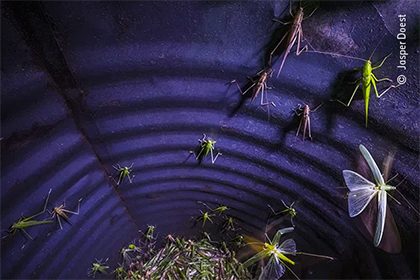
JASPER DOEST’S IMAGE – Drum catch
Jasper captured the vivid green colouration of nsenene as they attempted to climb the oily walls of the drum in which they were trapped.
Traps are said to fill much more slowly and unpredictably than they did in the 1990s. The decline is thought to be linked to the destruction of grasslands and wetlands where nsenene lay their eggs.
Menzione speciale – Premio storia fotogiornalistica

FOTO DI JASPER DOEST – Cattura nel bidone
Jasper ha colto il vivido colore verde dei nsenene mentre provavano ad arrampicarsi sulle pareti oleose del bidone in cui erano intrappolati.
Si dice che le trappole si riempiano più lentamente e in maniera meno prevedibile che negli anni Novanta. Il declino potrebbe essere causato dalla distruzione delle praterie dove la specie depone le uova.
Dettagli tecnici:
Leica SL + 16–35mm; 1/40 sec a f16 (-3 e/v); ISO 1600; flash Profoto B10

JASPER DOEST’S IMAGE – The market for nsenene
Sacks of freshly caught live bush crickets are unloaded at sunrise.
This protein-rich, nutritious seasonal snack is in high demand, and the Katwe Market in Kampala is soon full of customers. At the market nsenene can be sold live for home preparation, or boiled or deep fried, ready to eat on the spot.
Menzione speciale – Premio storia fotogiornalistica

FOTO DI JASPER DOEST – Il mercato dei nsenene
Sacchi di grilli appena catturati vengono scaricati all’alba.
Questo cibo stagionale ricco di protein è molto ricercato, e il mercato Katwe di Kampala è pieno di client.
I nsenene possono essere venduti vivi per preparazioni domestiche, o bolliti o fritti, per essere mangiati sul posto.
Dettagli tecnici:
Canon EOS R + 24–105mm f4; 1/250 sec a f11 (-0.3 e/v); ISO 3200
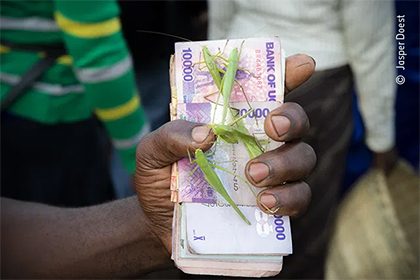
JASPER DOEST’S IMAGE – Insect cash
At the market, a buyer shows Jasper a handful of cash topped with a bush cricket to demonstrate that ‘nsenene is big business in Uganda’.
The harvest and sale of these insects has become an important source of income for some Ugandans in recent decades. However, as a growing number of trappers pursue the same unpredictable nsenene swarms, profits have become less certain.
Menzione speciale – Premio storia fotogiornalistica

FOTO DI JASPER DOEST – Cash entomologico
Al mercato, un compratore mostra a Jasper una mazzetta di banconote con i grilli, per dimostrare che “sono un grosso affare in Uganda”.
La raccolta e la vendita di questi insetti sono diventati un’importante risorsa per alcuni ugandesi negli ultimi decenni. I profitti però sono divenuti meno certi, perchè un numero sempre maggiore di raccoglitori insegue una sciamatura sempre più imprevedibile.
Dettagli tecnici:
Canon EOS R + 24–105mm f4; 1/160 sec a f11 (+0.7 e/v); ISO 2500
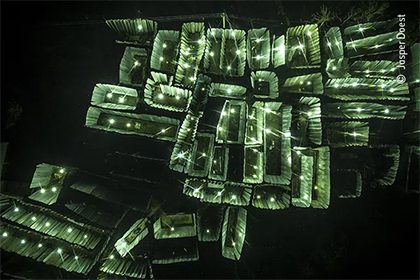
JASPER DOEST’S IMAGE – A swarm of traps
Taken from a drone, this image shows several nsenene traps set side by side.
Trappers hope the collective heat and glow of lights will draw larger swarms, yielding a greater harvest. Concerned about the sustainability of collecting wild bush crickets on a large scale and hoping to help address malnutrition in the region, scientists are working to find ways of farming the insects.
Menzione speciale – Premio storia fotogiornalistica

FOTO DI JASPER DOEST – Sciame di trappole
Fatta col drone, questa foto mostra numerose trappole per nsenene una accanto all’altra.
I raccoglitori sperano che metterle così attiri sciami più grandi, con raccolti più ricchi. Gli scienziati, preoccupati per la sostenibilità di questa pratica su larga scala e nel tentativo di ridurre la malnutrizione della regione, stanno provando ad allevare questi grilli.
Dettagli tecnici:
DJI Phantom 4; 1/40 sec a f2.8; ISO 400.
Tutti i contenuti, in qualunque forma espressi, offerti da www.radicediunopercento.it – originali o condivisi da siti esterni – sono redatti con la massima cura/diligenza e sottoposti ad un accurato controllo. Le fonti dei contenuti pubblicati in quest[o/a] [sito] [pagina], ove presenti, sono sempre indicate. Associazione Culturale Radicediunopercento, gli autori e/o gli amministratori del sito non si assumono alcuna responsabilità relativamente ad eventuali imprecisioni, errori, omissioni, danni (diretti, indiretti, conseguenti, punibili e sanzionabili) derivanti dai contenuti riportati in quest[o/a] [sito] [pagina].
La grafica, le immagini, i video e ogni altro contenuto presente su quest[o/a] [sito] [pagina], ove non diversamente specificato, appartengono ad Associazione Culturale Radicediunopercento, pertanto non potranno essere pubblicati, riscritti, commercializzati, distribuiti, radio o videotrasmessi, da parte degli utenti e dei terzi in genere – in alcun modo e sotto qualsiasi forma – senza preventiva autorizzazione da parte dei responsabili di Associazione Culturale Radicediunopercento. In relazione alle immagini e/o ai contenuti di cui l’Associazione non si dichiara espressamente autore, la stessa non detiene alcun diritto d’autore. Nei casi in cui non è citata la fonte, si tratta di materiale largamente diffuso su internet e ritenuto, pertanto, di pubblico dominio. Chiunque rivendicasse il copyright di qualsiasi immagine o contenuto presente o intendesse segnalare qualsiasi controversia riguardante i diritti d’autore, è pregato di contattarci inviando una e-mail all’indirizzo info@radicediunopercento.it2012® Associazione Culturale Radicediunopercento
P.iva 07987530966 – Codice Fiscale 97626690156